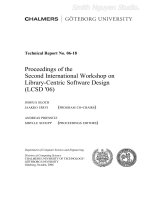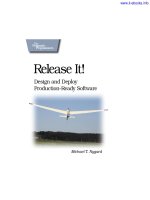Real-time Software Design
Bạn đang xem bản rút gọn của tài liệu. Xem và tải ngay bản đầy đủ của tài liệu tại đây (107.12 KB, 18 trang )
©Ian Sommerville 2004 Software Engineering, 7th edition. Chapter 15 Slide 1
Real-time Software Design
©Ian Sommerville 2004 Software Engineering, 7th edition. Chapter 15 Slide 2
Objectives
To explain the concept of a real-time system
and why these systems are usually
implemented as concurrent processes
To describe a design process for real-time
systems
To explain the role of a real-time operating
system
To introduce generic process architectures
for monitoring and control and data
acquisition systems
©Ian Sommerville 2004 Software Engineering, 7th edition. Chapter 15 Slide 3
Topics covered
System design
Real-time operating systems
Monitoring and control systems
Data acquisition systems
©Ian Sommerville 2004 Software Engineering, 7th edition. Chapter 15 Slide 4
Real-time systems
Systems which monitor and control their
environment.
Inevitably associated with hardware devices
• Sensors: Collect data from the system
environment;
• Actuators: Change (in some way) the system's
environment;
Time is critical. Real-time systems MUST
respond within specified times.
©Ian Sommerville 2004 Software Engineering, 7th edition. Chapter 15 Slide 5
Definition
A real-time system is a software system where
the correct functioning of the system depends on
the results produced by the system and the time
at which these results are produced.
A soft real-time system is a system whose
operation is degraded if results are not produced
according to the specified timing requirements.
A hard real-time system is a system whose
operation is incorrect if results are not produced
according to the timing specification.
©Ian Sommerville 2004 Software Engineering, 7th edition. Chapter 15 Slide 6
Stimulus/Response Systems
Given a stimulus, the system must produce a
response within a specified time.
Periodic stimuli. Stimuli which occur at
predictable time intervals
• For example, a temperature sensor may be polled 10
times per second.
Aperiodic stimuli. Stimuli which occur at
unpredictable times
• For example, a system power failure may trigger an
interrupt which must be processed by the system.
©Ian Sommerville 2004 Software Engineering, 7th edition. Chapter 15 Slide 7
Architectural considerations
Because of the need to respond to timing demands
made by different stimuli/responses, the system
architecture must allow for fast switching between
stimulus handlers.
Timing demands of different stimuli are different so a
simple sequential loop is not usually adequate.
Real-time systems are therefore usually designed as
cooperating processes with a real-time executive
controlling these processes.
©Ian Sommerville 2004 Software Engineering, 7th edition. Chapter 15 Slide 8
A real-time system model
Real-time
contr ol system
Actua torActua tor Actua torActua tor
SensorSensorSensor SensorSensorSensor
©Ian Sommerville 2004 Software Engineering, 7th edition. Chapter 15 Slide 9
Sensor/actuator processes
Data
processor
Actuator
control
Actuator
Sensor
contr ol
Sensor
Stimulus
Response
©Ian Sommerville 2004 Software Engineering, 7th edition. Chapter 15 Slide 10
System elements
Sensor control processes
• Collect information from sensors. May buffer
information collected in response to a sensor
stimulus.
Data processor
• Carries out processing of collected information
and computes the system response.
Actuator control processes
• Generates control signals for the actuators.
©Ian Sommerville 2004 Software Engineering, 7th edition. Chapter 15 Slide 11
Real-time programming
©Ian Sommerville 2004 Software Engineering, 7th edition. Chapter 15 Slide 12
Real-time programming
Hard-real time systems may have to
programmed in assembly language to
ensure that deadlines are met.
Languages such as C allow efficient
programs to be written but do not have
constructs to support concurrency or shared
resource management.
©Ian Sommerville 2004 Software Engineering, 7th edition. Chapter 15 Slide 13
Java as a real-time language
Java supports lightweight concurrency (threads and
synchronized methods) and can be used for some
soft real-time systems.
Java 2.0 is not suitable for hard RT programming but
real-time versions of Java are now available that
address problems such as
• Not possible to specify thread execution time;
• Different timing in different virtual machines;
• Uncontrollable garbage collection;
• Not possible to discover queue sizes for shared
resources;
• Not possible to access system hardware;
• Not possible to do space or timing analysis.
©Ian Sommerville 2004 Software Engineering, 7th edition. Chapter 15 Slide 14
System design
Design both the hardware and the software
associated with system. Partition functions to
either hardware or software.
Design decisions should be made on the
basis on non-functional system
requirements.
Hardware delivers better performance but
potentially longer development and less
scope for change.
©Ian Sommerville 2004 Software Engineering, 7th edition. Chapter 15 Slide 15
R-T systems design process
Identify the stimuli to be processed and the
required responses to these stimuli.
For each stimulus and response, identify the
timing constraints.
Aggregate the stimulus and response
processing into concurrent processes. A
process may be associated with each class
of stimulus and response.
©Ian Sommerville 2004 Software Engineering, 7th edition. Chapter 15 Slide 16
R-T systems design process
Design algorithms to process each class of
stimulus and response. These must meet the
given timing requirements.
Design a scheduling system which will
ensure that processes are started in time to
meet their deadlines.
Integrate using a real-time operating system.
©Ian Sommerville 2004 Software Engineering, 7th edition. Chapter 15 Slide 17
Timing constraints
May require extensive simulation and
experiment to ensure that these are met by
the system.
May mean that certain design strategies
such as object-oriented design cannot be
used because of the additional overhead
involved.
May mean that low-level programming
language features have to be used for
performance reasons.
©Ian Sommerville 2004 Software Engineering, 7th edition. Chapter 15 Slide 18
Real-time system modelling
The effect of a stimulus in a real-time system may
trigger a transition from one state to another.
Finite state machines can be used for modelling
real-time systems.
However, FSM models lack structure. Even simple
systems can have a complex model.
The UML includes notations for defining state
machine models
See Chapter 8 for further examples of state machine
models.
©Ian Sommerville 2004 Software Engineering, 7th edition. Chapter 15 Slide 19
Petrol pump state model
Card
inser ted
into reader
Timeout
Resetting
do: displayC C
error
Initialising
do: initialise
display
Paying
Stopped
Reading
do: getC C
details
Waiting
do: display
welcome
do:
deliver fuel
do: debit
CCaccount
Payment ack.
Ready
Delivering
update display
Nozzle
trigger on
Nozzle trigger off
Nozzle trigger on
Hose in
holster
do: validate
credit card
Validating
Invalid card
Card removed
Card OK
Hose out of holster
Timeout
©Ian Sommerville 2004 Software Engineering, 7th edition. Chapter 15 Slide 20
Real-time operating systems
Real-time operating systems are specialised
operating systems which manage the processes in
the RTS.
Responsible for process management and
resource (processor and memory) allocation.
May be based on a standard kernel which
is used unchanged or modified for a particular
application.
Do not normally include facilities such as file
management.
14
©Ian Sommerville 2004 Software Engineering, 7th edition. Chapter 15 Slide 21
Operating system components
Real-time clock
• Provides information for process scheduling.
Interrupt handler
• Manages aperiodic requests for service.
Scheduler
• Chooses the next process to be run.
Resource manager
• Allocates memory and processor resources.
Dispatcher
• Starts process execution.









